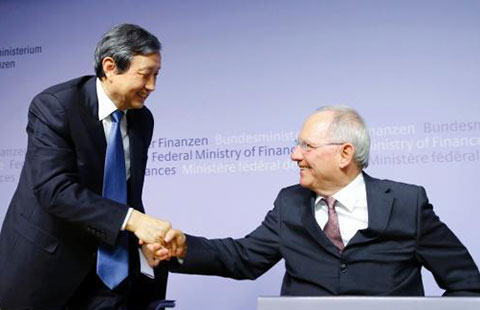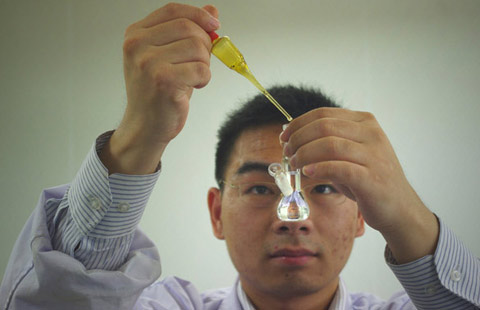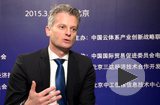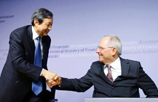Seven opportunities of China's economy under the 'new normal'
By Chen Yulu (chinadaily.com.cn) Updated: 2015-03-05 10:08
 |
|
Chen Yulu, president of Renmin University of China. [File photo / IC] |
China's economy steps into the "new normal" phase, as it is growing in a manageable and relatively balanced manner. Confronted by a weakening overseas market, sliding domestic demand, adjustments in real estate sector and a deeper-level structural shift, the country faces mounting pressure of economic slowdown.
However, the "new normal" does not only mean difficulties, challenges and risks. We still have the assertion that China's economy still has great strategic opportunities and can make great achievements. What has changed is the connotation and condition of this great opportunity.
China's economy is still featured with the fundamentals that it is growing in a healthy manner, with its development mode and economic structure changed. So the "new normal" of China's economy is breeding a great development opportunity with which the country, as a rising power, embraces the new economic system.
First, the opportunity of major reforms and adjustments. The financial crisis in 2008 exposed the serious structural problem in the world's economy, and pronounced the end of China's traditional growth approach. Problems such as great energy consuming and severe pollution along with the high investment, social economic conflict along with the gap in income distribution, and the insufficiency of innovation plagued by excessive control have become hurdles for China to realize a prosperous country, affluent livelihood and the national rejuvenation.
Chinese people have realized that the major reforms and adjustments are the only choice to restructure the fundamentals of China's social and economic developments. The consensus reached in the "major reforms" and "major adjustments" is the best gift that the "new normal" brings to the next round of China's economic development. It gives China a great opportunity amid the worldwide structural reforms.
Second, the opportunity in major consumption, major market and constructing the "effect of major economy". Other countries may be amazed to find that China, while stabilizing its position as the world's second largest economy, has its market demand and domestic consumption greatly improved.
The demand from China becomes a key factor in the world's demand and the "effect of a major economy" has revealed. For the first, the great scale and scope of China's economy, with the improvement of productivity offsetting the rise of various costs, does not lower its market demand in the world. For the second, the consumption is accelerating, as China's consumption is growing on an average speed of 13 percent every year.
Along with the expansion of demand from China, the purchase made by China has become a core factor to stabilize the world's economy. China is shifting its role from "the world's factory" to the "world's market". For the last, the role as the "world's factory" has been linked with that of the "world's market", and thus integrates the domestic trade with international trade. It makes the country's economy more stabilized and greatly improves its capability to deal with the turbulence in the world's economy.
Third, the opportunity in great potential and constructing pluralistic growth poles. By the end of 2014, the index in China's every industry has shown that China's economy is shifting to post-industrialization, and the dividend of industrialization is wearing out. But we must see the great dimension and size of China's economy. The Yangtze River Delta region, Pearl River Delta region, and Beijing-Tianjin area have shifted to a growth mode significantly driven by the service industry.
But the per capita GDP in the vast central and west China as well as northeastern China is still lower than $5,000, with the industrialization in these areas remaining fast development in medium term. It will make way for upgrading the industry in the coastal areas, meanwhile accelerate the development in western areas. So the great shift of China's industry greatly slows down the receding of dividend of China's industrialization. By constructing the pluralistic growth poles, the layout of China's growth is more scientific.
Fourth, the opportunity from "talents" and seeking second round of demographic dividend. The arrival of Lewis Turning Point and drawing close of aged society mean the traditional population dividend of China is wearing off. But it must be pointed out that it is only in the migrant worker sector that the problems of "being difficult to hire qualified workers" and "labor cost being on the rise" are most prominent. The layout of China's employment market features both "the difficulty of college students to land a job" and "the lack of migrant workers".
With up to 7 million college students graduating every year, the starting salary of these students have started to draw close to that of farmer-turned workers. But that is the key point for China to shift from a populous country to one with powerful human resources.
It manifests that a large number of well-educated people have prepared China's industry upgrading with massive highly qualified and low-cost backup reserves. The second round of population dividend that features college students and human resources is replacing the traditional population dividend that features migrant workers and low-end labor force.
Fifth, the opportunity from "major innovation" and constructing technology dividend. When screening the various indexes of China's technology innovation, we will find that the new innovative development approach is taking shape while the extensive mode of economic development comes to an end. First, there is a significant growth in the number of patent applications: the number reached 2.577 million in 2013, up 15.9 percent. It accounts for 32.1 percent of the world's total, ranking the top in the world. Second, the expenditure in R&D increased significantly: it accounts for 2.09 percent of China's GDP in 2014, up 12.4 percent, or growing in a high-speed, moderate intensity level. Third, there is a great boost in the prosperity of technology market: in 2013 the trade volume in technology market reached 746.9 billion yuan, up 16 percent. Fourth, the export of high-tech products rose substantially, with the total volume climbing to $660.3 billion, or 30 percent of the total export volume. Fifth, the number of technology papers published overseas drew close to 300,000, making China one of the major powers of technology papers. Sixth, China boasts the world's largest team of researchers in science and technology sector. All these figures show that China will gradually obtain the dividend in technological innovation as long as it deepens reforms in technological system and encourages all kinds of innovative and creative activities. "Made in China" is shifting to "Innovate by China", along with the shift from labor intensive manufacturing to knowledge intensive industries.
Sixth, the opportunity in major upgrade and planning an upgrading version of China's economy. China's economy has shown the symbols of overall upgrading under the multiple influences including market, technology and human resources. For one, the consumption behavior has shown substantial upgrading as per capita GDP drew close to $8,000.
The industrialized-style consumption that centers on basic needs of food, clothing, housing and traffic in the past 30 years begins to shift to post-industrialized consumption that features high-end finished product and service. For the other, driven by the demand, the industry has started a major shift from manufacturing to service sector, from labor intensive industry to technology intensive sectors. An upgrading version of China's economy is taking shape.
Seventh, the opportunity in major opening-up and global layout of China's economy. The overall elevation of China's economic power and the change in layout of global economy because of the 2008 financial crisis grant China an unprecedented opportunity to carry out major opening-up and global layout. First, China begins to shift from the "era of exporting commodities" to the higher level of "capital export". The direct investment in overseas market is rising substantially, with major increases in overseas mergers and acquisitions.
The average growth rate surpassed 30 percent, as the FDI in overseas market surpassed $100 billion. Second, the set-up of regional free trade zone radiates the related areas during the process of opening-up. Third, centered on the "One Belt and One Road" project, a full integration will be carried out between China's spatial strategy and opening-up strategy.
China will form new international partnership through links and communication. Fourth, the setup of the world's financial institutes including the New development Bank, Asian Infrastructure Investment Bank and Silk Road Fund breaks the industry landscape dominated by Europe and the United States. These developments expand China's space in resources distribution and its profitability mode, and will bring China to a new stage of development.
For sure, to secure the above seven opportunities and transfer all strategic chances into real growth and development, we need to tackle effectively all kinds of problems and challenges that the "new normal" faces. We need to roll out a system that adapts to the next-round of economic development on the back of full and deepened reforms.
The author is president of Renmin University of China. The views do not necessarily reflect those of China Daily.
- Israel requests to join Asian Infrastructure Investment Bank
- Chinese stocks rebound on April 1
- China, the West in Africa: more room for cooperation than competition
- Nanjing cuts taxi franchise fees
- Air China increases flights to Milan, Paris
- JD.com raises delivery charges
- Veteran corporate strategist upbeat about China economy
- L'Oreal China sales revenue up 7.7% in 2014

















